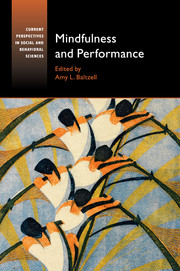Book contents
- Frontmatter
- Dedication
- Epigraph
- Contents
- List of figures
- List of tables
- List of contributors
- Preface
- Acknowledgments
- I INTRODUCTION TO MINDFULNESS: HISTORY AND THEORETICAL UNDERSTANDING
- II FORMAL MINDFULNESS INTERVENTIONS IN SPORT
- III MINDFULNESS: THEORY TO PRACTICE IN SPORT AND EXERCISE
- IV MINDFULNESS AND THE PERFORMING ARTS
- 15 Langerian Mindfulness and Optimal Performance
- 16 Mindfulness and Dancers
- 17 Attention, Centering, and Being Mindful: Medical Specialties to the Performing Arts
- 18 Mindfulness in Music
- V MINDFULNESS FOR COACHES, PRACTITIONERS, AND MENTORS
- VI FUTURE DIRECTIONS
- Index
- References
16 - Mindfulness and Dancers
from IV - MINDFULNESS AND THE PERFORMING ARTS
Published online by Cambridge University Press: 05 January 2016
- Frontmatter
- Dedication
- Epigraph
- Contents
- List of figures
- List of tables
- List of contributors
- Preface
- Acknowledgments
- I INTRODUCTION TO MINDFULNESS: HISTORY AND THEORETICAL UNDERSTANDING
- II FORMAL MINDFULNESS INTERVENTIONS IN SPORT
- III MINDFULNESS: THEORY TO PRACTICE IN SPORT AND EXERCISE
- IV MINDFULNESS AND THE PERFORMING ARTS
- 15 Langerian Mindfulness and Optimal Performance
- 16 Mindfulness and Dancers
- 17 Attention, Centering, and Being Mindful: Medical Specialties to the Performing Arts
- 18 Mindfulness in Music
- V MINDFULNESS FOR COACHES, PRACTITIONERS, AND MENTORS
- VI FUTURE DIRECTIONS
- Index
- References
Summary
Within the preceding decade, researchers have gained rapid interest in understanding mindfulness in sport performance. Mindfulness in sport research has included exploring differing conceptual models; understanding the relationship of mindfulness to other factors, such as flow, attention and affect; and providing empirical evidence that supports the implementation of specific mindfulness-based interventions (see Pineau, Glass, & Kaufman, 2014). Similar to sport, the performing arts are another domain of human performance, and as such, parallels are commonly drawn between the two, particularly the physical-based pursuits of sport and dance. This has led to many theoretical and applied practice models from the field of sport psychology being applied directly into the world of dance, with a growing body of research becoming evident that critically highlights the suitability and applicability of such an approach (see Nordin-Bates, 2012). As a result, this chapter aims to provide an overview of the current research and exploration of mindfulness with dancers, with particular focus upon the implementation of a mindfulness meditation (MM)–based program within the curriculum of a university dance training program.
Mindfulness in Performance
Mindfulness has its roots in Eastern meditation, specifically in a contemplative Buddhist practice called vipassana (Andersen, 2012; Park-Perin, 2010). Kabat-Zinn's (2005) definition of mindfulness (i.e., nonjudgmental, moment-to-moment awareness) is utilised regularly as the foundation for conceptualising mindfulness within performance domains and incorporates two components: regulation of attention in order to maintain focus within the present moment; and adopting an acceptance- and openness-based approach to personal experiences (Bishop et al., 2004).
Moore and Gardner (2014), and many of their colleagues within a sporting context who implement modern-day approaches to mindfulness, often adopt these Eastern traditions and apply them within the frameworks of Western psychological science. Some of these mindfulness approaches, whether intentionally or not, resulted in implementation of mindfulness that also focuses upon the act of drawing novel distinctions that can be developed without meditative practices (e.g., Langer, 1989). While this Langerian mindfulness approach is viewed as more goal-directed with a focus upon the processing of information that is external to the individual (Pineau et al., 2014), its conceptualisation has also been observed to align with the theoretical underpinnings of Acceptance and Commitment Therapy (ACT) (Hayes & Wilson, 1994) – a clinical therapeutic approach that forms one of the key foundations of the Eastern-influenced Mindfulness-Acceptance-Commitment (MAC) intervention utilised within the sport and performance domains (Gardner & Moore, 2010).
- Type
- Chapter
- Information
- Mindfulness and Performance , pp. 367 - 388Publisher: Cambridge University PressPrint publication year: 2016
References
- 3
- Cited by



